THE HYDRAULIC ORGAN
The most exceptional thing about the organ is that we know the name of the inventor. Many
other instruments are attributed to mythical persons or the instruments excist longer then
the time wherin te so-called inventor lives. Notable, the inventor of the organ was an engineer.
His name is Ctesibius of Alexandria. He was the son of a barber who concentrated oneself on
technical stuff. The date of the invention is set on 246 BC. One is not sure of the date,
but the period is right. On his account, there are also moving birdstatues, watergames and
hosepipes. We all know this thanks to different classical writers. Among them: Hero the Old
of Alexandrie (Pneumatica, I, Chapter 42), Philo of Byzantium and the most important of them
all, Vitruvius. He was an important man among Caesar. He build armymachines for him and
for August he did restoration works at the aquaducts. He wrote a large book called 'De Architectura'
in which he talks about everyting you can imagine and also about the hydraulic organ. He
gives an concise yet not simple description of the organ and how you build such a thing.
Vitruvius was, just like Ctesibius, an engineer.
For the technical description of the organ, I base myself on the tradition of Hero of
Alexandria. He describes the most basic organ, the prototype of Ctesibius. The organ
of Vitruvius is just an extension of this type. It differs in the amount of suction pumps and
rows of pipes. On the base, their rest an water tank. Next to this, a pump stood in connection
with a cilinder which hang at the reservoir. Above this tank, there was a wind chest wherein
the air came in. And all the way above you had the pipes. The avarage is eight, but sometimes
you could find to 18 different registers. How in the hell did you operate this thing ?
The pictures make this more clear.
Picture 1 (left):
It shows how person A operates the pump by which the pistons force air in tube D. Their are
two air valves. One in the cilinder that has the take to let air in when the piston goes down,
but not the other way around. The second valve (F) is located at the end of tube D which
goes over in space G where the water is. Its task is also to assure that the air can not
flow back to the other side. The air in space G has the task to rise the water in space H,
because these two are connected with a little hole (I). When the valve goes down, there
is still enough pressure of the water to force the air in tube J to the windchest.
Picture (right): Here you can see how the air is divided into the pipes. When
the player strikes a tone (A), it pushes the glider C until opening D crosses opening E.
On this way, air comes into the pipe. The quill (F) has the task to let the note come back
to his original position.
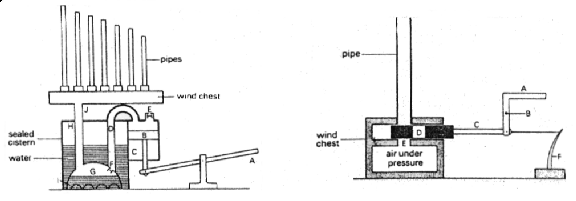
Pictures: New Dictionary of Music & Musicians
Read here the text of Hero (Engels)
And here the description of an organ that works with a
little windmill
The organ of Vitruvius has more registers. In the windchest, there is a 'floor' which is
divided into various compartiments. The registers are operated with an iron handle which
are situated under the keyboard. The organ is build more aesthetic and symmetric. At both
sides, you can see beautifull dolphins. At their mouth their is a little chain and at the
end of it there is a lid.
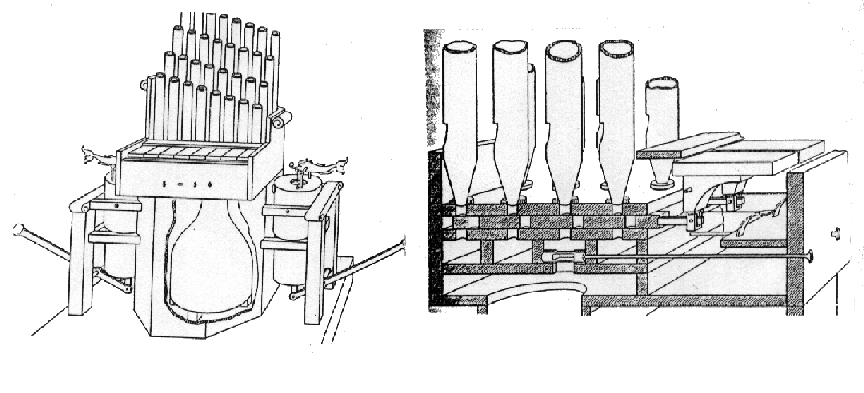
Picture: Het orgel
At a certain moment in history, one has taken the decision to build a pneumatic organ.
The first one to mention this is Jullius Pollux, but one assumes that the origin lies
around the beginning of the Emperor-era. One used bellows instead of using the complicated
system of the waterorgan. Still, it didn't became so succesful as the hydraulic organ.
Striking fact is that still, they builded it with an waterchest and so in spite of the
drawbacks such as freezing danger (water freezes! :-) and the big weight. The reason for the
succes of the hydraulic organ is that is was far more interesting for the intelectuals
because of its technical aspects. These things provide also a much louder sound, ideal
at the theater and son.
Organ music:
Between practice and theory of the organ, their lies a wide gap. From the descriptions
and the discovery of one organ (cf. under) we cannot learn much about the musicological
aspects of the instrument. Especially, the timbre and the height of the tones are a problem.
The question which arise concerning the timbre is this: Did the organ have besides copper
pipes also have pipes made out of reed. Because, sources say that sometimes the sound was
very sweet, other say very dark and heavy. The latter is linked with pipes made out of reed.
Pictures however do not show pipes made out of reed. And the organ of Aquicum (cf under) had
pipes made out of copper. This discussion is going on for a long time, and for some
people its an absurd one ! The second problem that of the height of tones. Studies of the
organ of Aquincum deliver us conflicting results. Walcker-Mayer support the hypothesis taht
the organ was tuned diatonical. Perrot says that it is tuned chromatic. Nowadays, one follows
Bellerman who says that the organ was able to play in 5 different tunings. Finally, could
the organ play polyphonic, which is the general question: was the music in Antiquity
Uberhaupt polyphonic ? We get confirmation if we studie pictures of the organ, but we
have to keep in mind that pictures do not always reveal reality ! Problem is that
them music in se was non-polyphonic !
rise and fall:
in the beginning, the organ was seen as a technical wonder, more than a musical instrument.
But later on, it became popular, especially in games. We know for example that in Delphi
in 90 BC, an organcompetion was won by Antipatros. The first one to mention the organ
in Roman writings was Cicero (160-43 BC). He compares the sound of the organ with
the finest food and the most sensual feelings. In the imperial age, the succes of the organ
was enormous. Everyone who had a big status played on it (emperors, philosphers..) Nero
promised that if he could control the Gaul, he would play in the Circus. In the second
century, it became very popular: you could see the organ on coins, oil lamps were made of it..
Because of the migrations in the fifth and sixth century, the presence of the organ fell down.
It still lived in the East after Constantine had made Constantinopel the capital of the
Roman Empire.
relics: We have many interesting things from antiquity concerning the organ. An
important source are the contorniates. These coins were printed for special occasions like
parties at the theater and so on.
This is a contorniaat dating from the time of Nero. At the backside of the coin, there
is a non-identifying person standing left from an organ. The words LAURENTI NICA can point
to the fact that Laurentius won a game or was the most famous organplayter at that time.
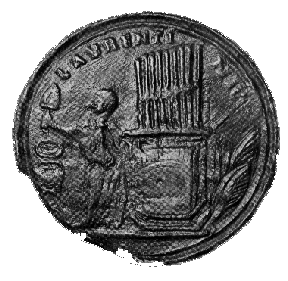
Picture: Cabinet Des Medailles
On this coin, we can see two persons. It dates from the government of Traianus (98-117).
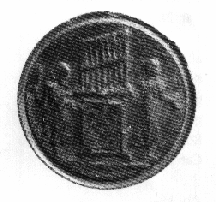
Picture: Koninklijk Penningkabinet Leiden
This one is from the government of Valentiniaan (424-455). At the backside, you can
identify the words PLACEAS PETRI. Peter was apparently a virtuoso at that time. More important,
you can also see two little boys who operate the airpumps.
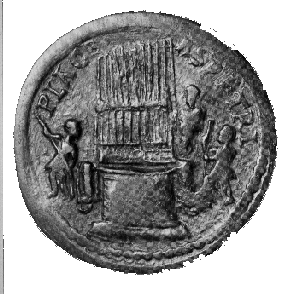
Picture: Cabinet Des Medailles
Several centres specialized in maken oil lamps existed in the Antiquity. In Carthago,
their was a special one, who only made oil lamps in the shape of organs. This one on the
pictures was found at Carthago with the date of 175-250. The inscription POSSESSORIS points to
the ceramics workplace 'Pullaen Possessor'. At the front, we can see different pipes and
- important - the two holes in which you had to put the oil. The back side shows the player,
unfortunately not conserved as a whole.
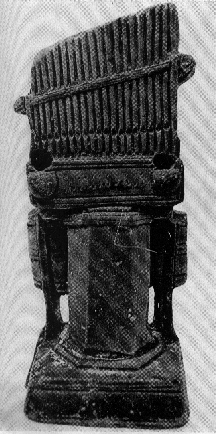
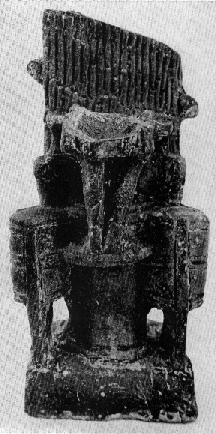
Picture left: National Museum Copenhagen
Picture right: National Museum Carthago
In Trier, in the villa of Nennig, one discoverd in 1852 a mosaic which
portrayed an orgelscene.
It dates from the government of Hadrianus (138-177). Next to the the organplayer, there is
a hornplayer. Together, they accompanied probably a gladiatorfight. These two instruments
were mostly used in the music at the theater.
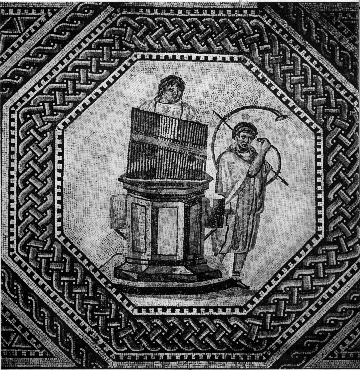
Picture: Rheinisch Landesmuseum Trier
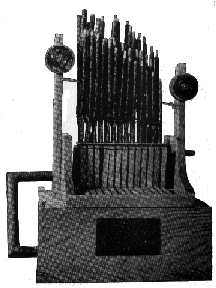
The most spectaculair disovery is an organ ! Until now, it is the only one we have found.
I'm talking about the organ of Aquincum. It was found in 1931 at Colonia Aquincum, which
is now Budapest. It was founded in the club house of the fireman which burnt in the second
halve of the third century AD. We know when the organ was given to the club house, so the
date of construction will not be far of this datedonation. The inscription says: 'Gaius
Julius Viatorinus, member of the council (decurio) of the Colonia Aquincum, Aedil and head
of the college of weavers (who served as well as fireman), has donated this organ at his costs,
as a gift, in the time that Modestus en Probus were Consul (this was 228 AD).
The wooden and leather parts of the organ are lost in the fire. But thanks to the
bronze parts, the size, form and construction could be calculated. De Organbuilder Gangsters
made a reconstruction. It's a fact that it's not completely right as the original.
The organ had 4 rows, every row had 13 pipes. Therefore, you had 4 registers. If this was
origanilly a hydraulic is not sure, because when they made windorgans, one still made
the waterchest underneath !
Click here for a
profile
of the organ
At the diggings of Pompei, an decoration plate of an organ was found. The rest of the instrument was burnt
by the extreme heat of the lava.
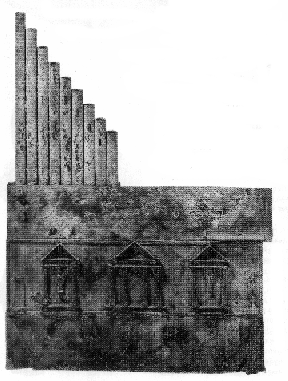
Picture: Kopie conserved in the Gemeentemuseum Den Haag, original in Archeologisch Museum te Napels










